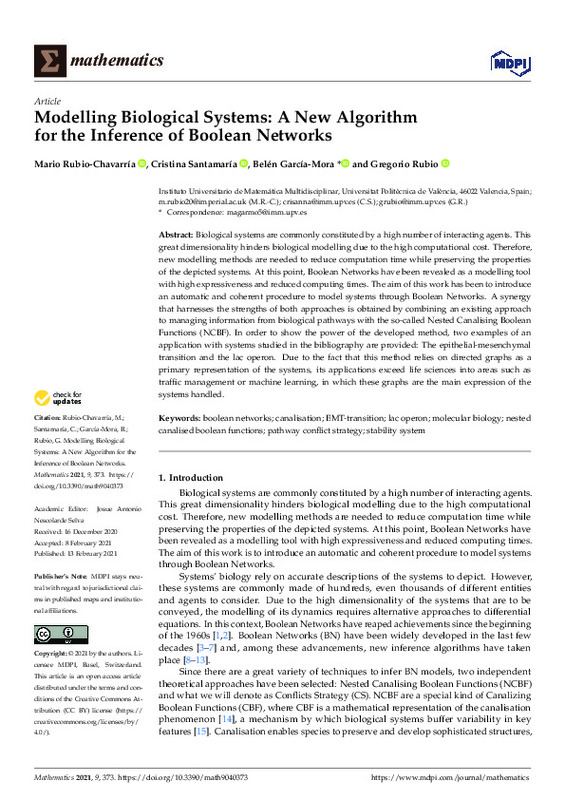JavaScript is disabled for your browser. Some features of this site may not work without it.
Buscar en RiuNet
Listar
Mi cuenta
Estadísticas
Ayuda RiuNet
Admin. UPV
Modelling Biological Systems: A New Algorithm for the Inference of Boolean Networks
Mostrar el registro sencillo del ítem
Ficheros en el ítem
| dc.contributor.author | Rubio-Chavarría, Mario
|
es_ES |
| dc.contributor.author | Santamaria Navarro, Cristina
|
es_ES |
| dc.contributor.author | García Mora, María Belén
|
es_ES |
| dc.contributor.author | Rubio Navarro, Gregorio
|
es_ES |
| dc.date.accessioned | 2022-02-04T19:03:44Z | |
| dc.date.available | 2022-02-04T19:03:44Z | |
| dc.date.issued | 2021-02 | es_ES |
| dc.identifier.uri | http://hdl.handle.net/10251/180504 | |
| dc.description.abstract | [EN] Biological systems are commonly constituted by a high number of interacting agents. This great dimensionality hinders biological modelling due to the high computational cost. Therefore, new modelling methods are needed to reduce computation time while preserving the properties of the depicted systems. At this point, Boolean Networks have been revealed as a modelling tool with high expressiveness and reduced computing times. The aim of this work has been to introduce an automatic and coherent procedure to model systems through Boolean Networks. A synergy that harnesses the strengths of both approaches is obtained by combining an existing approach to managing information from biological pathways with the so-called Nested Canalising Boolean Functions (NCBF). In order to show the power of the developed method, two examples of an application with systems studied in the bibliography are provided: The epithelial-mesenchymal transition and the lac operon. Due to the fact that this method relies on directed graphs as a primary representation of the systems, its applications exceed life sciences into areas such as traffic management or machine learning, in which these graphs are the main expression of the systems handled. | es_ES |
| dc.description.sponsorship | This paper has been supported by the Generalitat Valenciana grant AICO/2020/114 | es_ES |
| dc.language | Inglés | es_ES |
| dc.publisher | MDPI AG | es_ES |
| dc.relation.ispartof | Mathematics | es_ES |
| dc.rights | Reconocimiento (by) | es_ES |
| dc.subject | Boolean networks | es_ES |
| dc.subject | Canalisation | es_ES |
| dc.subject | EMT-transition | es_ES |
| dc.subject | Lac operon | es_ES |
| dc.subject | Molecular biology | es_ES |
| dc.subject | Nested canalised boolean functions | es_ES |
| dc.subject | Pathway conflict strategy | es_ES |
| dc.subject | Stability system | es_ES |
| dc.subject.classification | MATEMATICA APLICADA | es_ES |
| dc.title | Modelling Biological Systems: A New Algorithm for the Inference of Boolean Networks | es_ES |
| dc.type | Artículo | es_ES |
| dc.identifier.doi | 10.3390/math9040373 | es_ES |
| dc.relation.projectID | info:eu-repo/grantAgreement/GENERALITAT VALENCIANA//AICO%2F2020%2F114//MODELIZACION MATEMATICO-COMPUTACIONAL DEL CARCINOMA VESICAL/ | es_ES |
| dc.rights.accessRights | Abierto | es_ES |
| dc.contributor.affiliation | Universitat Politècnica de València. Departamento de Matemática Aplicada - Departament de Matemàtica Aplicada | es_ES |
| dc.description.bibliographicCitation | Rubio-Chavarría, M.; Santamaria Navarro, C.; García Mora, MB.; Rubio Navarro, G. (2021). Modelling Biological Systems: A New Algorithm for the Inference of Boolean Networks. Mathematics. 9(4):1-22. https://doi.org/10.3390/math9040373 | es_ES |
| dc.description.accrualMethod | S | es_ES |
| dc.relation.publisherversion | https://doi.org/10.3390/math9040373 | es_ES |
| dc.description.upvformatpinicio | 1 | es_ES |
| dc.description.upvformatpfin | 22 | es_ES |
| dc.type.version | info:eu-repo/semantics/publishedVersion | es_ES |
| dc.description.volume | 9 | es_ES |
| dc.description.issue | 4 | es_ES |
| dc.identifier.eissn | 2227-7390 | es_ES |
| dc.relation.pasarela | S\431318 | es_ES |
| dc.contributor.funder | GENERALITAT VALENCIANA | es_ES |
| upv.costeAPC | 1000 | es_ES |








